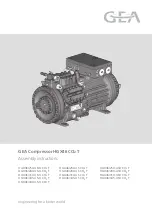
1: Safety
185 T3 Kubota User Manual
02250223-054 R01
8
Subject to EAR, ECCN EAR99 and related export control restrictions.
1.13 Towing
1
1.13.1 Preparing to tow
A.
Prior to hitching the air compressor to the tow vehi-
cle, inspect all attachment parts and equipment,
checking for (I) signs of excessive wear or corrosion,
(II) parts that are cracked, bent, dented or otherwise
deformed or degraded, and (III) loose nuts, bolts or
other fasteners. Should any such condition be pres-
ent,
DO NOT TOW
until the problem is corrected.
B.
Back the tow vehicle to the compressor and position
it in preparation for coupling the compressor.
C.
If the compressor is provided with a drawbar latched
in the vertical upright position, carefully unlatch draw-
bar and lower it to engage the coupling device. If not,
raise drawbar with the jack to engage coupling
device or otherwise couple the compressor to the
towing vehicle.
D.
Make sure the coupling device is fully engaged,
closed and locked.
E.
If chains are provided, pass each chain through its
point of attachment on the towing vehicle; then hook
each chain to itself by passing the grab hook over
(not through) a link. Cross chains under the front of
drawbar before passing them through points of
attachment on towing vehicle to support the front of
drawbar in case it should accidentally become
uncoupled.
F.
Make sure that the coupling device and adjacent
structures on the towing vehicle (and also, if utilized,
chain adjustment, brake and/or electrical intercon-
nections)
DO NOT
interfere with or restrict motion of
any part of the compressor, including its coupling
device, with respect to the towing vehicle when
maneuvering over any anticipated terrain.
G.
If provided, make sure chain length, brake and elec-
trical interconnections provide sufficient slack to pre-
vent strain when cornering and maneuvering, yet are
supported so they cannot drag or rub on road, terrain
or towing vehicle surfaces which might cause wear
that could render them inoperative.
WARNING
Do
NOT
tow the compressor should its weight
exceed the rated limit of the tow vehicle, as the
vehicle may not brake safely with excess weight.
See rated limit in tow vehicle Operator's Manual,
and review its instructions and other require-
ments for safe towing.
WARNING
This equipment may be tongue heavy.
DO NOT
attempt to raise or lower the drawbar by hand if
the weight is more than you can safely handle.
Use the screw jack provided or a chain fall if you
cannot lift or lower it without avoiding injury to
yourself or others. Keep hands and fingers clear
of the coupling device and all other pinch points.
Keep feet clear of drawbar to avoid injury in case
it should slip from your hands.
WARNING
This equipment may be tongue heavy.
DO NOT
attempt to raise or lower the drawbar by hand if
the weight is more than you can safely handle.
CAUTION
Retract the front screw jack only after attaching
the compressor to the tow vehicle. Raise the
screw jack to its full up position and pull the pin
connecting the jack to the drawbar. Rotate the
screw jack to its stowed position, parallel to the
drawbar, and reinsert the pin. Make sure the jack
is secured in place prior to towing.
If a caster wheel is provided on the screw jack it
is part of the screw jack and can not be
removed. Follow the same procedure for stow-
ing away the wheeled jack as you would for the
standard screw jack. Pull the pin connecting the
jack to the drawbar and raise the screw jack to
its full up position. Rotate the screw jack to its
stowed position, parallel to the drawbar, and
reinsert the pin. Make sure the jack is secured in
place prior to towing.
1
While not towed in the usual sense of the word, many of these instructions are directly applicable to skid-mounted portable air compressors as well.













































